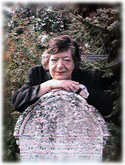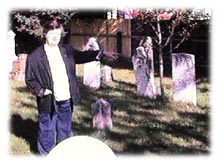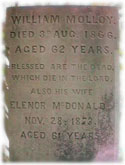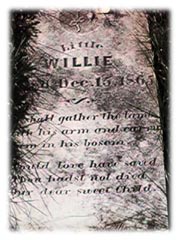
 Recording Gravestone Information Recording Gravestone Information
There's nothing more frustrating than going somewhere to carry out a task then finding you left some crucial item behind. The same holds for cemetery research.
The basics tools needed should be listed on a checkoff sheet. It is a good idea to keep them in a container which can be taken at a moment's notice when the urge hits you to find a new cemetary.
Looseleaf foolscap is best because it is lined. Make sure the first page is titled with the name of the cemetary and its location. After that, number each page. Being mere mortals we tend to make errors of omission and forget to record someone's first or last name, etc. Another reason is that you may have reason to return at a later date, perhaps for a photograph which has been requested.
A pattern in the recording pages facilitates going back to a particular stone or cross without aimless searching. Indicate on the page where you start (1st row closest to road) or any other notation to help find the spot later.
There are times that the dates appear to belong to the spouse and not the deceased. In some areas and times it was the custom to inscribe like this:
On Canada's East Coast 12-04-1904 can be interpreted as either December 4, 1904 or April 12, 1904. This comes about from our dual French-English cultures: it all depends on whether a French-speaking or English-speaking person gave instructions to the inscriber. If either of the numbers is over 12 you can logically determine which is which. Good news! It has been my experience that very few were written in this way.
You will find some dates that are not clear. If, after using your whole bag of tricks, you still cannot be precise, then record it for example as 19?7, or 185? or 1852 /1857 .
Do not ignore any bit of date
information that can be seen. It could be very significant to the researcher.
A stone might have:
Quite often there will be a man, woman and one or two children together but with separate stones. If the family name is common to that cemetery, make a note of their proximity to each other. This doesn't necessarily mean husband, wife and child but will certainly help the researcher in determining what direction to take for further analysis.
Record ALL data on the stone. Some stones list several first names on the side of, or below, that of the deceased. This could represent children's or siblings' names so they are very important. A good example of this kind of data is:
This seems, at first glance, to give very little information. But look at it closer. It says she had at least one child, and as such was probably married considering the time frame of her life. Then the researcher can decide whether Smith is her maiden or married name and carry on from there.
You may find a stone on which a family name is written more than once. And, believe it or not, the name may not be spelled the same in each case. For example: Russell and Russel. Whatever the spelling, keep to the inscription and do not attempt to correct it.
Also, many stones were home-made by uneducated people. One stone which comes to mind was located in a predominantly French-Canadian cemetery in an area of French/Scottish intermarriages. The name was Dugal. There is a French name Dugas but this stone had first names on it which were definitely of Scottish origin. On closer consideration, the original name was most likely Dougall and the person carving spelled it as it sounded.
Adopt these simple rules and you won't go wrong. Of course, the problem of how to read undecipherable text crops up its pointy head from time to time... but fear not! That shall be covered in another installment of Musings from the Cemetery.
Part One: Introduction to the Wonderful World of Cemetery Research
Part Two: Recording Gravestone Information
Part Three: The Face of a Gravestone
Part Four: Cleaning Gravestones
Part Five: Restore or Beautify?
Part Six: Are Your Ancestors Buried Here?
Part Seven: Visit to an Ancestor
Contact Patsy by E-Mail |
Thursday, December 26th, 2019
Attention visitors: Tartans.com is back. Please note that this is a snapshot of the site as it existed nearly 20 years ago and you may encounter broken links; we are still combing through the site and correcting those as we find them. Please also note that some sections are currently not functional, primarily the discussion forums/clan chat boards.
|
** HOME - First Time Visitors - Glossary - - Contact Us ** Awards | Bibliography | Clan Calendar | Clan Chat | Clan Finder | History | Famous Scots | Genealogy | Great Hall of the Clans | Links | News and Features | Scots on the Net | Search | Site Map The Gathering of the Clans
Copyright 1995- Tartans.com - All Rights Reserved. |
 Follow the same pattern of recording no matter who does it. Keep each stone's information in the same paragraph, lines single spaced. Skip a line to record next stone, and so on. Print everything. A person's handwriting is not necessarily easy to read and leaves too much margin for error in transcribing to another medium. There is usually a family name prominent. Print this name to the left, all other information to be indented on page. This makes for easier scanning or for typing it later.
Follow the same pattern of recording no matter who does it. Keep each stone's information in the same paragraph, lines single spaced. Skip a line to record next stone, and so on. Print everything. A person's handwriting is not necessarily easy to read and leaves too much margin for error in transcribing to another medium. There is usually a family name prominent. Print this name to the left, all other information to be indented on page. This makes for easier scanning or for typing it later. It is John who is buried here. Perhaps his wife is too, but no dates as yet for her. Dates can be a real problem if they have only numbers for months and days.
It is John who is buried here. Perhaps his wife is too, but no dates as yet for her. Dates can be a real problem if they have only numbers for months and days. It is quite obvious that the single date for John is his birth date and his death is not inscribed here. After all, he could be elsewhere in the cemetery or perhaps in another cemetery altogether. Children are usually in a section by themselves, often with only one date such as 1936. Make a notation in parentheses (in children's area) so that he/she is not interpreted as being an adult.
It is quite obvious that the single date for John is his birth date and his death is not inscribed here. After all, he could be elsewhere in the cemetery or perhaps in another cemetery altogether. Children are usually in a section by themselves, often with only one date such as 1936. Make a notation in parentheses (in children's area) so that he/she is not interpreted as being an adult.